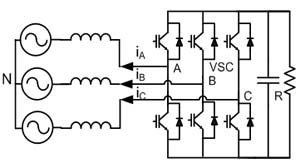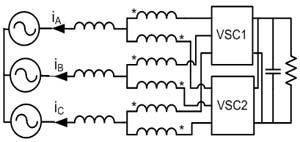LIBRARY
Improved Asymmetric Space Vector Modulation for Voltage Source Converters with Low Carrier Ratio

This paper presents an improved asymmetric space vector modulation (ASVM) for two level voltage source converters (VSCs) when the switching frequency is only 9 times of line frequency. By adding two pulses in each line cycle when the fundamental voltage crosses zero, the total harmonic distortion (THD) of output current can be reduced significantly with very limited penalty. The applications of improved ASVM in a single VSC or two interleaved VSCs systems are shown separately in Fig. 1 and Fig. 2. With optimization, the ac current THD can be reduced to as low as 50% for single VSC and even lower to 20% for interleaved VSCs systems. Such THD reduction has close relationship with modulation index and interleaving angle. In addition, improved ASVM can also reduce the amplitude of circulating current which mainly determined the size of interphase inductors. Finally, the weights of total inductors needed to meet the same THD requirement are compared to demonstrate the benefits of improved ASVM when different PWM schemes are used. The analysis results are verified by experiments on a demo system. The example results are shown in Fig. 3 and Fig. 4. From Fig. 3, the THD of output current is 17.8% (100%) for single VSC system with traditional ASVM. From Fig. 4, the THD of output current is reduced to 5% (28%) for two paralleled VSCs system with 90° interleaving.

























































































